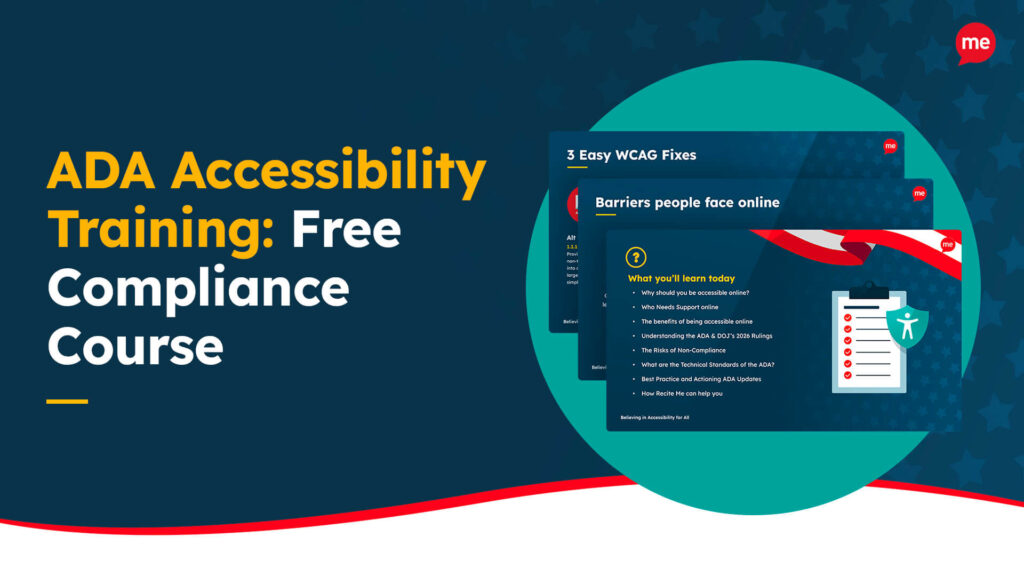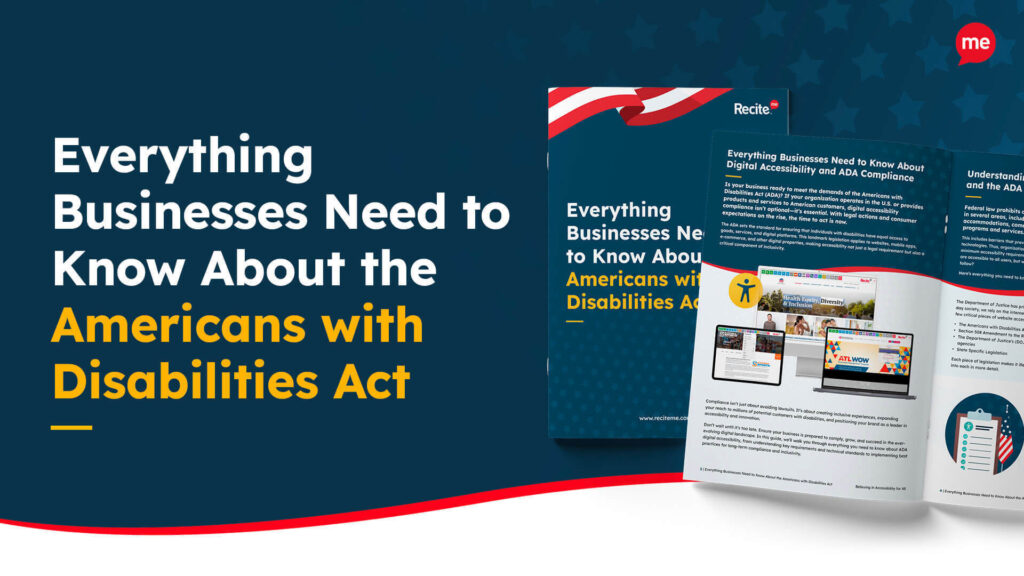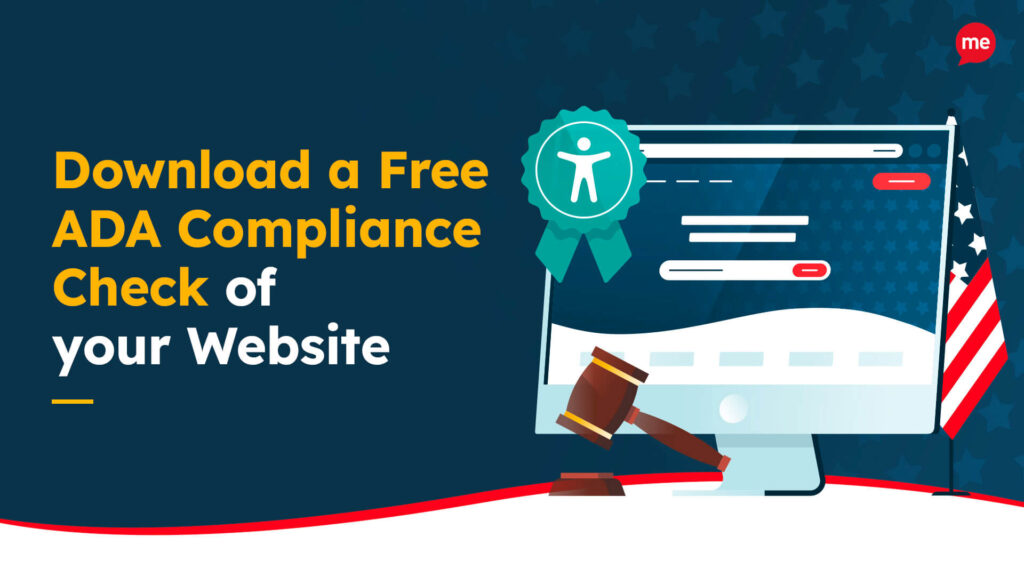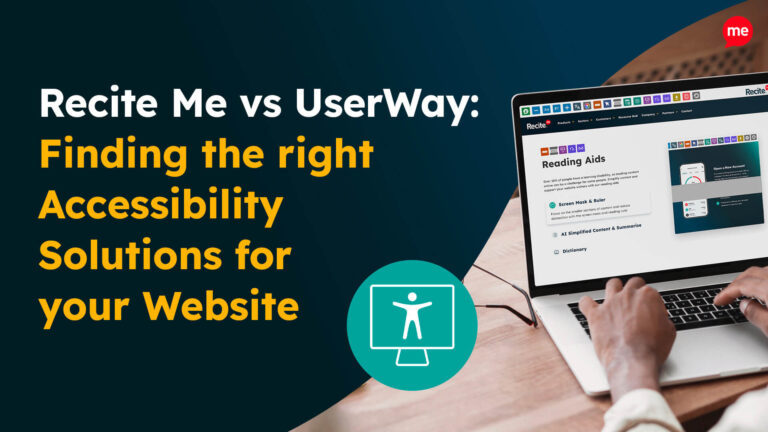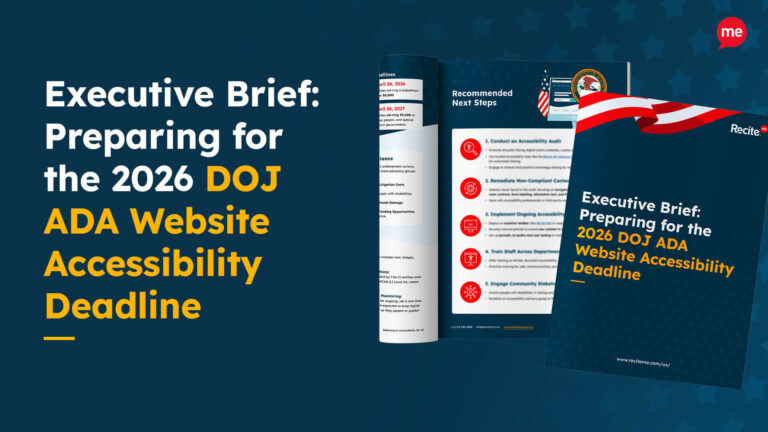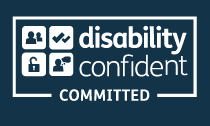Get A Free ADA Compliance Audit Of Your Website
Download NowSince its signing in 1990, businesses have been required to ensure their physical spaces comply with the Americans with Disabilities Act (ADA). But what many business owners don’t know is that the ADA applies to digital spaces as well. If your website is not ADA-compliant, you could be opening the floodgates to a barrage of potential lawsuits and everything that comes with it. In this article, we’ll break down what the ADA requires of your online spaces, help you determine whether it applies to your business, and show you practical steps to make your website more accessible starting today.
What is the Americans with Disabilities Act (ADA)?
The Americans with Disabilities Act, enacted in 1990, aims to eliminate discrimination against disabled individuals in all areas of life. It covers physical accessibility, like ramps and handrails, as well as digital accessibility, such as websites and apps. Initially, website accessibility wasn’t included, but the ADA is now interpreted to apply to websites since they’re public spaces, much like physical businesses.

The ADA has five categories, or titles, outlining its scope:
- Title I: Employment
- Title II: Public entities
- Title III: Public accommodations
- Title IV: Telecommunications
- Title V: Miscellaneous provisions
While each title has specific requirements, the overall goal is to ensure disabled individuals can fully participate in daily life.
In Washington, state laws like the Washington Law Against Discrimination (WLAD) bolster these regulations, prohibiting discrimination in public accommodations and employment. Together, these laws guide businesses in ensuring accessibility.
Want to make sure your website is compliant with the Americans with Disabilities Act? Then unlock the ADA compliance checklist now. Discover actionable steps to ensure ADA compliance, helping you avoid lawsuits and any other negative consequences of non-compliance.
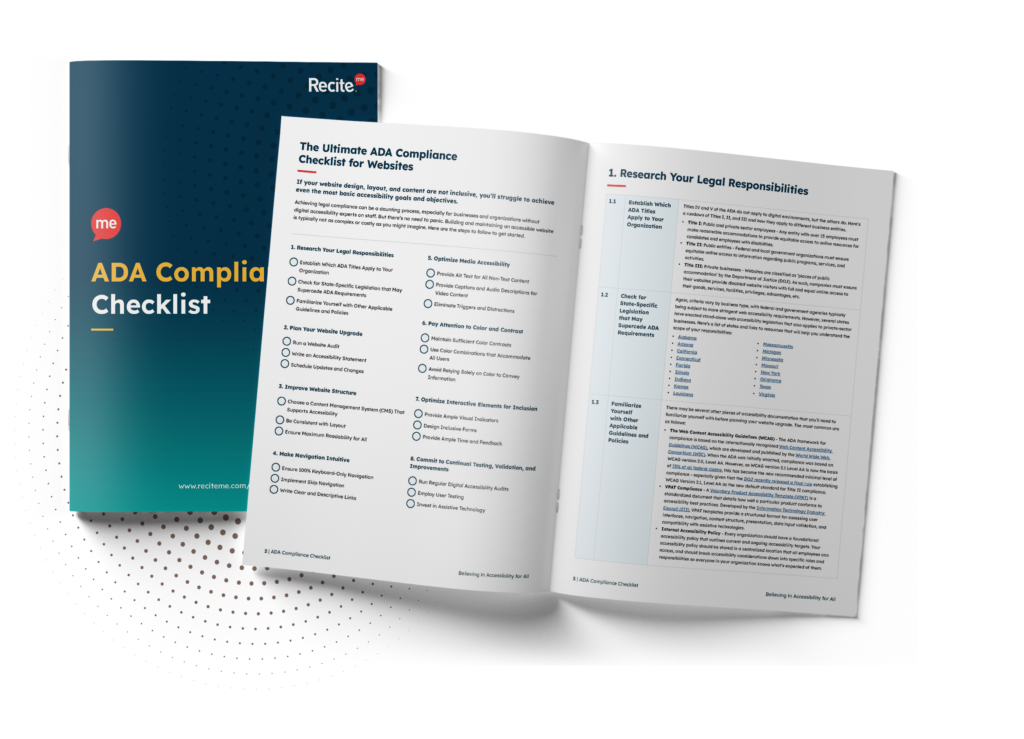
Which Washington businesses need to comply with ADA guidelines?
Now that you know a bit more about the ADA, it’s time to find out if you fall within its remit. The reality is, you probably do. The ADA is a broad and encompassing law, which applies to just about any business, local government, or public entity with a website. Here’s the breakdown:

- Employers, both public and private, with more than 15 employees are required to make reasonable accessibility accommodations for their staff under Title I of the ADA.
- Under Title II of the ADA, all state and local government entities, such as Washington public services, must meet accessibility standards.
- Title III requires any business classified as a public accommodation to comply with the ADA. This includes hotels, restaurants, retail stores, healthcare facilities, and any entity that provides goods or services to the public. Crucially, this applies to websites.
Even if your organization isn’t explicitly required to comply with the ADA, prioritizing accessibility brings significant benefits to your business. First and foremost, it mitigates legal risks, reducing the likelihood of getting tangled up in a costly lawsuit. But it also opens up your business to a broader market and helps you rank positively among ethically-conscious consumers.
Tips for ensuring ADA web compliance in Washington
The ADA applies broadly to most Washington-based businesses, but what does that mean for your website? How can you ensure compliance? ADA website compliance is rooted in the Web Content Accessibility Guidelines (WCAG), which means that to become ADA compliant, you must first be WCAG compliant. To help you navigate this, we’ve examined the most common WCAG failures and compiled a list of actionable tips to get your website checkmark-ready.
1. Audit your website
A comprehensive accessibility audit is an obvious starting point. An audit allows you to identify existing WCAG failures and accessibility weak points so that you know which areas require immediate attention. This makes your accessibility journey more streamlined and targeted. Use an automated tool like the an accessibility checker for quick results, and combine this with manual auditing for more complete results.
Get started and learn how to audit your website for ADA compliance here.
2. Add Image Alt Text
Alt text is a written description of an image, allowing screen readers to convey its content to visually impaired users who rely on screen readers. Each and every image or visual element on a website should have alt text. A restaurant in Washington, for example, might feature images of its menu items on the website. These images should all have appropriate alt text descriptions, such as, “A plate of spaghetti carbonara with garlic bread on the side”.

3. Test for mobile accessibility
With around 60% of web traffic coming from mobile devices, ensure your site is responsive and easy to navigate on both smartphones and tablets. To test for this ensure that your website’s design is responsive and can adapt to any screen size. Additionally, ensure that all touch targets are appropriately sized and are easy to access.
4. Ensure Sufficient Color Contrast
Ensure text stands out clearly against its background. The WCAG Level AA standard recommends a contrast ratio of at least 4.5:1 for normal text. In practical terms, this means avoiding colors that clash, like light gray text on a white background.
5. Make your website keyboard accessible
Many users rely on keyboards instead of a mouse to navigate websites. Ensure all interactive elements, like menus and buttons, are accessible using standard keyboard functions like the Tab and Enter keys.
6. Provide closed captions for videos
If your website features promotional videos, include closed captions so that individuals with hearing impairments can follow along. A Washington-based winery might choose to caption a virtual tour of its vineyard, for example, ensuring that all website visitors have access to the information they need before making a purchasing decision.

7. Use Descriptive Link Text
Instead of vague link text, ensure your links are descriptive. Hyperlinked text should provide context as to the link’s destination. For example, “Learn more about our Seattle office hours” is a clearer and more accessible alternative to “Click here”.
8. Implement ARIA Labels
Accessible Rich Internet Applications (ARIA) labels help screen readers interpret dynamic web elements. For example, ARIA labels can clarify the function of a dropdown menu, button, or checkbox, helping disabled website visitors use your website more effectively.

9. Create a clear website structure
Organize your website content thoughtfully by using headings, subheadings, and lists to create a logical flow. Start with a main heading (H1) for the page’s primary topic, followed by subheadings (H2, H3) to break down key sections. Use bulleted or numbered lists to simplify information and make it more digestible.
A well-structured site enhances user experience for everyone, but it’s particularly beneficial for those relying on assistive technologies, such as screen readers, which rely on clear hierarchies to navigate content efficiently. Proper structure also improves SEO, helping your site reach a wider audience.
10. Train your team
Invest in training for your team on accessibility best practices so they understand how to maintain an accessible website. This knowledge ensures ongoing compliance as your site evolves and helps future-proof your site against potential lawsuits.
You can download the free ADA training course here.
What are the risks of ADA non-compliance in Washington
Failing to make your website ADA compliant opens the door to potential lawsuits. If not addressed proactively, these lawsuits can set off a domino effect of negative consequences. Let’s unpack a few of them.
Damage to reputation
Word spreads quickly in the digital age. Details of a lawsuit and the associated allegations can soon become public knowledge. This knowledge alone is enough to deter potential customers and damage your brand’s reputation, particularly in a market which increasingly values ethical purchasing decisions.
Financial penalties
Non-compliance can result in lawsuits and hefty fines. Businesses found guilty of ADA violations may face settlements reaching $75,000 for first time violations, with even higher fines for repeat offenders.
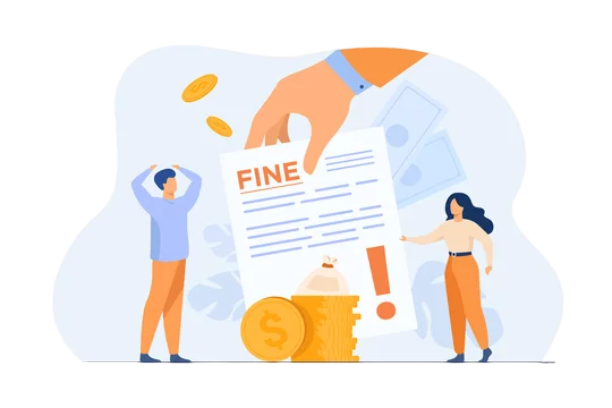
Loss of business opportunities
An inaccessible website immediately excludes 13% of Washington residents who live with a disability. This translates to a significant loss of potential customers, and that’s before factoring in friends and family members who are likely to show solidarity with their loved ones. Flipping this on its head, an accessible website, in contrast, attracts a broader audience.
Get a free automated ADA compliance audit of your website. This audit will highlight compliance violations and provide the recommendations needed to meet ADA compliance standards.
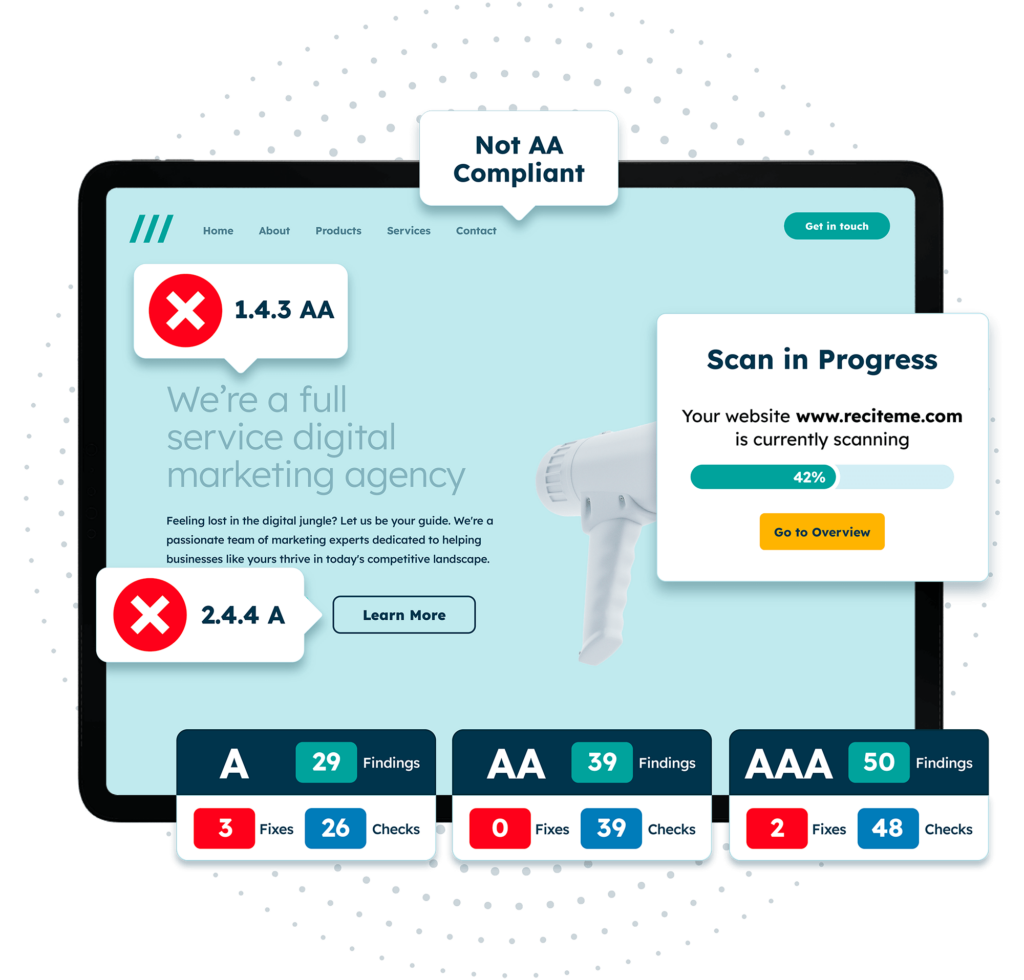
Real ADA lawsuit examples in Washington
In 2023, the number of ADA lawsuits filed in America reached 4,600, 97% of which have been found to target websites in particular. This surge in digital accessibility lawsuits has turned modern web design into a minefield of potential legal penalties. Unpacking some famous Washington cases can help illuminate the high stakes of non-compliance and highlight the importance of prioritizing accessibility.

Bob Kramer of Kramer Knives
In the case of Kramer Knives, Bob Kramer, owner of Kramer Knives in Bellingham, Washington, is reported to have spent nearly $40,000 on legal expenses due to a lawsuit alleging that his website was inaccessible and violated the ADA. This case highlights the financial risk of getting involved in such lawsuits; even the litigation costs alone can be enough to upend your business’s finances.
U.S. Department of Justice v. Washington State Parks
In this ADA lawsuit involving Washington State Parks, there were allegations of ADA violations at Paradise Point State Park. A camping area designated for individuals with disabilities had deep ruts, causing injuries to a complainant with mobility issues.
Under the settlement, Washington State Parks will create and implement ADA compliance policies, inspect facilities, and address accessibility issues statewide. The agency will also train staff, establish grievance procedures, and begin remediation by October 2025, with progress reports required for seven years. This agreement ensures improved accessibility across all Washington State Parks facilities.
Need more help becoming ADA compliant?
The following resources are packed full of actionable tips and expert advice for making your digital content compliant with the Americans with Disabilities Act:
Free ADA Accessibility Training
Take the first step to ADA compliance by completing our training course.
Free ADA Accessibility Guide
Ensure your organization is meeting the requirements for ADA compliance.

